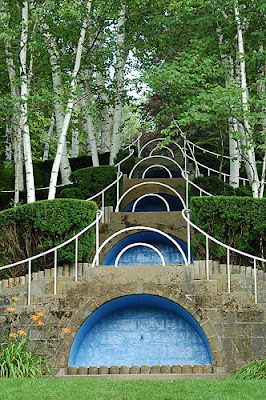It is mystery to me that our house in the Catskills has no discernable front door. Mysteries can be solved by careful observation, but it took me longer than it should have to recognize that our present approach to the house bears no relation whatsoever to the plan of the original owner.
 |
| Abandoned steps |
In the early years of the 20th century a visit to the country was more leisurely and of longer duration than our present hurried every-weekend run. The walk to the front door was part of the experience. Once you look to the past, and if you spend enough time poking around old houses perched on hillsides, you are likely to find remnants of the abandoned stone staircases that once led logically to the front door.
Today we are shaped to a large extent by the arrival of four-wheel drive vehicles and the 21st century necessity of doing all the heavy work ourselves. We are most concerned with how close we can get to the house to off-load groceries, garden supplies, tools, laptops, book-bags and small children. At our house, there is now a straight uphill drive hospitable to SUVs, but with no sense of arrival at what might constitute the front door. We are obliged to meet guests before they emerge from their cars to prevent them from wandering in through the garage or the kitchen.
The original 1918 entrance to the house was probably very different. There is still a road that makes a gentle entry up a slight rise and then runs along the base of the bluff on which the house sits. The remnants of a stone staircase climbs uphill to the edge of the curving stone wall that mediates between the house, its lawns, and the wilderness of the lower slopes and arrives smack at the center of the long porch opposite french doors that open to what was most likely the front hall of its day.
 |
| Abandoned garage with gate to stairs |
The same situation holds true for our neighbor down the road, Scott Blair. He has a similar abandoned staircase but in much better shape than ours. His driveway circles around and uphill until you arrive at a landing pad with the house and garden below. But well before you start the uphill drive you pass an unused garage at the foot of the hill and alongside it is a stone staircase, still quite usable, that climbs to the front of the house. In its present arrival pattern dictated by unloading the automobile, the Blair driveway, as ours, has no relationship to the front door.
Abandoned staircases are a delight to discover, and are akin to the ruins and follies created in the 18th century English landscapes of Capability Brown. Ours are natural occurrences, the results of changing patterns, but no less amenable to continued use as part of an overall plan for moving through a landscape that still holds surprises. They can become secret gardens.
 |
| Fletcher Steele's blue staircase |
At the other extreme, Fletcher Steele’s famous Blue Staircase at Naumkeag is announced with an almost audible “Tad da!” Designed by McKim, Mead and White in 1885, the house and grounds are owned and managed by the Trustees of Reservations, an organization devoted to maintaining properties of exceptional aesthetic and environmental value throughout Massachusetts. The grounds were first designed in the 1880s by Nathan Barrett and expanded between 1926 and 1956 by the owner Mabel Choate and her landscape architect Fletcher Steele.
Far removed from the romantic rusticity of the Catskills, the Berkshires reflect the great extravagances of the Gilded Age. Although the terraced formal gardens are far removed from how we understand gardens today, it is well worth a visit if only to a see Steele’s tour-de-force of a staircase.
On a more modest scale, stone steps and staircases abound in gardens today. Unfortunately, the craftsmanship is often disappointing, so if you are headed in this direction read up on stonework before you start, and be sure to select a master. A good guide book is Dan Snow’s Listening to Stone.
After a while you will be able to sort good from bad, and understand the fine distinction between stones, their origins and their handlers. I needn’t include pictures of what to avoid. Instead take a look at a picture of subtle stone steps that appear to have been in place forever. These steps were photographed the day they were set in place, cutting through a pumpkin patch.
 |
| Steps through pumpkin patch |
In the Catskills, stone is the most plentiful product. Almost every property has its crop lying about in the woods. Winter’s alternate freezing and thawing have heaved rocks to the surface for as long as records have been kept. Stone can speak to you the way a landscape speak to you, if you pay attention. It tells you how to use it. “Here I am,” it says. “ I am your front step. I am your walk, your pathway. I am here.”